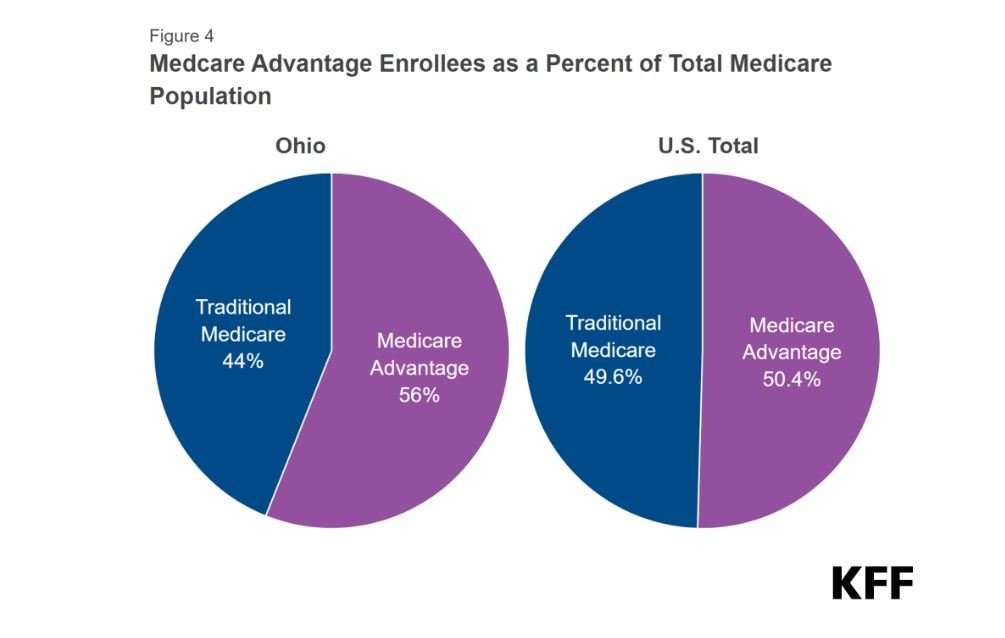Health Care in Ohio
By KFF
Health care is a concern for voters whether or not it determines their electoral decisions in national, state and local races. These state snapshots provide data on a range of timely topics to describe the health care landscape in which policy debates in the election will unfold.
Health Coverage and Costs
In Ohio, there were 667,400 uninsured people in 2022. That’s 5.8% of the state’s population compared to 8.0% of the U.S. population being uninsured.
While over 90% of the U.S. population has some form of health insurance, medical debt continues to be an issue with at least $220 billion owed in 2021.
About 810,000 or 9.1% of adults in Ohio report having medical debt in a given year from 2019 and 2021. The U.S. average of people reporting medical debt is 8.6%.
Medicaid and CHIP
Medicaid and CHIP provide health and long-term care coverage to 80.9 million low-income children, pregnant women, adults, seniors, and people with disabilities across the U.S. as of May 2024.
Total Medicaid and CHIP enrollment in Ohio was 2.9 million in May 2024.
Total Medicaid spending in fiscal year 2022 was $30.3 billion in Ohio; the federal government paid 77.1% of these Medicaid costs.
Since March 2023 when the Medicaid continuous enrollment provision that paused disenrollments during the COVID-19 pandemic ended, Ohio has disenrolled 867,445 people from the program. Medicaid and CHIP enrollment is 12.3% higher than before the start of the pandemic in February 2020.
Medicaid and CHIP income eligibility levels in Ohio, as in most states, vary for different categories of people.
ACA Marketplace Coverage
Over 20 million people have purchased nongroup coverage through the Affordable Care Act (ACA) and most (93%) qualify for premium tax credit assistance through health insurance marketplaces. The premium tax credit assistance was enhanced with the passage of the American Rescue Plan Act (ARPA) in 2021 and extended by The Inflation Reduction Act (IRA)through 2025.
During 2024, 466,776 Ohio residents enrolled in a plan through the marketplace. Enrollment in the state has increased by 167% since 2020.
About 90% of enrollees in the state received an advanced premium tax credit to help them pay their premium.
Employer-Sponsored Insurance
Employer-sponsored insuranceis the largest source of health coverage in the nation, covering more than 158 million people in the U.S.
The average annual premium for employer-sponsored coverage for families in 2023 was $23,895 in Ohio.
The average deductible for private-sector employees enrolled in family coverage in 2023 was $3,886 in Ohio, higher than the U.S. average ($3,811).
Medicare and Part D Prescription Drugs
Medicare is a federal health insurance program that covers people age 65 and older and younger adults with long-term disabilities.
In 2024, there were 2,516,184 total Medicare beneficiaries in Ohio.
In 2024, 132,547 Medicare beneficiaries were enrolled in Part D coverage in Ohio.
In 2025, Medicare beneficiaries will pay no more than $2,000 out of pocket for prescription drugs covered underPart D, Medicare’s outpatient drug benefit. This is due to a provision in theInflation Reduction Act of 2022(IRA).
In Ohio, there were 149,000 Part D enrollees who spent more than $2,000 out of pocket in at least one year from 2017-2021.
Beginning in 2023, the IRA limits monthly cost sharing for insulin products to no more than $35 for Medicare beneficiaries.
Ohio had 139,880 Part D insulin users in 2020.
Women’s Health
States vary widely on policies related to women’s health coverage and access. These policies include Medicaid eligibility levels for pregnant and postpartum women, paid leave laws, and policies shaping access to abortion and contraception services.
Maternity Policies
The share of births financed by Medicaid in Ohio was 40% in 2022.
The 2024 Medicaid and CHIP income eligibility level for pregnant women is 205% of the federal poverty level in Ohio.
Ohio has adopted the Medicaid 12-month postpartum coverage extension.
For parents to maintain Medicaid eligibility after pregnancy coverage ends in Ohio, their income must be below 138% of the federal poverty level.
Ohio has not enacted paid family leave or paid sick leave laws as of 2023.
Abortion Policies
The U.S. Supreme Court 2022 decision overturning Roe v. Wade’s federal constitutional standard on abortion has led to wide variation in states’ policies on access to abortions.
Ohio has a gestational limit for abortion.
Ohio restricts abortion at 22 weeks lmp with exceptions for life and physical health.
Telehealth abortions now account for 1 in 5 abortions nationally. Ohio allows telehealth medication abortion with no restrictions.
Contraception Policies
Contraception access policy has gained attention after the Supreme Court’s abortion ruling. Ohio does have legal protections in place for the right to contraception.
Gender Affirming Care
Ohio has enacted laws or policies limiting youth access to gender affirming care.








